I think I finally have to accept that any campaign setting I make will eventually turn into a Frazetta painting.
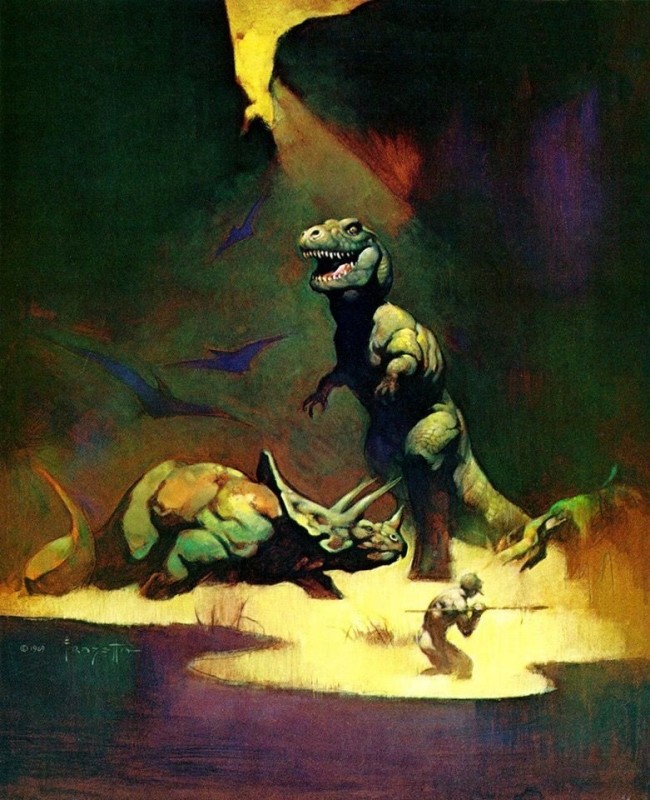 Barbarians riding on dinosaurs fighting masked sorcerers in ancient skull-decorated towers are just too damn cool!
Barbarians riding on dinosaurs fighting masked sorcerers in ancient skull-decorated towers are just too damn cool!
Yora's site for Sword & Sorcery RPGs
Some people quite regularly complain about Medieval Stasis in fantasy worlds, with swords, armor, and castles that are thousands of years old looking just the same as those made in the present day. Which I guess is fair to some point, but on the other hand, we actually get to see these ancient things only very rarely. Who is actually saying that things thousands of years in the past looked exactly as medieval as in the present?
Something that has been bothering me much more recently is how lots of fantasy worlds seem to portray countries and governments in a very static way. The same peoples living in the same places for many centuries or thousands of years, with borders rarely changing in any meaningful way. Which is not at all how kingdoms and empires progressed historically. As historians like to frequently repeat, the idea of a nation state is a very recent concept. But there is also the old story of “medieval people rarely went more than 30 km from their home in their entire life”. Which again might be fair to some point, since most people were farmers and as such wouldn’t commonly move to a different city for a new job. But when local circumstances made it necessary or desirable to give up the old farm and set up a new one somewhere else, then on many occasions they really would move astonishing distances.
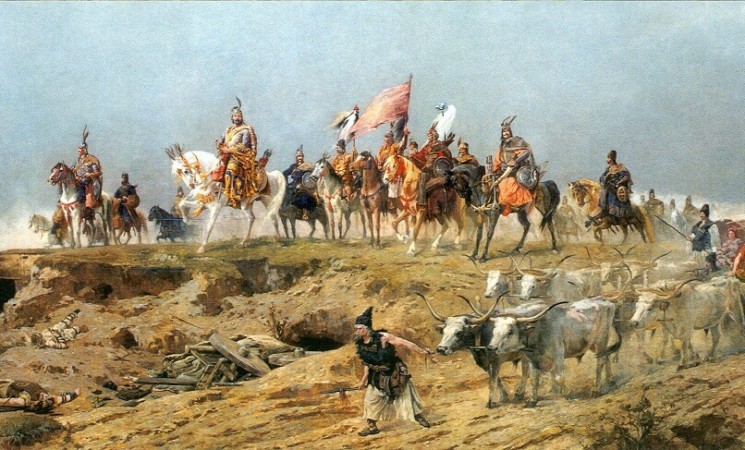 Even though I’m quite a fan of Bronze Age history, the periods that really have been fascinating me the most in recent years are the conquest of the Persian Empires by Greeks in the 4th century BCE and the Migration Period of late Antiquity and the early Middle Ages from the 4th to 6th century CE. Well over 2000 years ago, you had Greek aristocrats being the ruling class in Afghanistan. 600 years later, a group of Scandinavians who were living on the Black Sea went on a campaign that made their sons and grandsons kings in Tunesia after conquering Spain. In 5th century France, warlords from Denmark and Kazakhstan were trying to carve out pieces of the Roman Empire for themselves.
Even though I’m quite a fan of Bronze Age history, the periods that really have been fascinating me the most in recent years are the conquest of the Persian Empires by Greeks in the 4th century BCE and the Migration Period of late Antiquity and the early Middle Ages from the 4th to 6th century CE. Well over 2000 years ago, you had Greek aristocrats being the ruling class in Afghanistan. 600 years later, a group of Scandinavians who were living on the Black Sea went on a campaign that made their sons and grandsons kings in Tunesia after conquering Spain. In 5th century France, warlords from Denmark and Kazakhstan were trying to carve out pieces of the Roman Empire for themselves.
Now it seems unlikely that the entire populations of whole countries suddenly packed up everything and started walking for several thousand miles. With the Greek conquest of the Persian Empire, it was explicitly an army on campaign that was recruiting new additional forces from the local rulers who switched to their side. In the migration period of Europe, migrating groups are estimated to consist of only 10 to 20,000 people each, with the total number of people on the move over several centuries probably being well under a million. The German term of “Peoples Marches” for the period is somewhat misleading in that way. You didn’t have entire populations exchanging the places where they lived. Most of the peasant population would likely have remained the same while it was the warrior elites who claimed rulership over the land which in some cases would change every few decades. But when you want to ask “Where did the Visigoths live?”, you have to include the specific year. And I am pretty sure that over in the East, there were some warlords who did major conquests in both China and Europe during different times of their lives. Which then didn’t hold very long after, but that only shows even more how extremely fluid things were in regards to who rules what places.
Yes, in many ways, the world is much smaller now than it was even just one or two centuries ago. But it was never actually that big to begin with. When creating a history for fantasy worlds, consider that not just kings come and go, but the peoples who inhabit the various countries do as well.
People who’ve been following what I write for some time might know that I often come up with plans for grand ideas but rarely have anything finished to present later. Since I don’t have any money at stake with all this elfgame stuff, that’s fine. And it’s rare that I actually abandon anything I’ve been working on completely. Much of stuff that I create is tinkering with mechanics and concepts and it’s always a learning experience that helps me increase my understanding of the material. And nearly all of it kind of just goes into a drawer where I let it sit for some months or a few years while my attention is on other things, to get pulled out again at some later point to continue tinkering with it. So while it might be pretty early to make any kind of announcement yet for what I am currently working on and nothing might come out of during the next year or so, my current plans for a rules system and campaign setting are actually just a new phase of the same things I’ve been working on for nearly 10 years now. I am constantly getting better at it and feel like I am making great progress, but with increasing experience comes a better understanding of how far away the goal has actually been all along. It’s a bit like fusion power research, I guess.
With a lot of talk, confusion, and general uncertainty about the licensing situation of D&D type games in the last month, plenty of people have come out with the opinion that this is as good a time as there’s ever been to just go through with their ideas of what a perfect game system should look like and make it happen. Though in full self-awareness of how much interest and use such systems might actually see, the old term of fantasy heartbreakers immediately made it back into circulation. It’s not going to be the next Dungeons & Dragons or the next Pathfinder, and most likely not even the next Swords & Wizardry. This is something you do just for the fun of it and maybe to use for your own campaigns, and perhaps, if you’re lucky, it becomes popular enough that some people will take bits and pieces as house rules for their own campaigns. And in this mood and environment, why the hell not? I’ve been collecting quite some house rules myself over the years which I already put together as the Yora Rules, and there’s a number of things in B/X that I would personally have done very differently.
There are actually three connected but separate things that I want to make:
At this stage, these are really more general plans for a playtest than specific plans for a product. These are plans to develop something, which depending on how things work out, could at a later point lead to releasing something.
OSRIC and OSE already set great examples for how you could replicate the structure of AD&D and B/X even with the OGL 1.0a, and with the new Creative Commons license for the SRD 5.1, I feel that all of this is both perfectly within both the letter and spirit of the law.
I started RPGs with D&D 3rd edition just when it came out and later played some Pathfinder for a while. It was fine back then because it was what I knew, but when I became curious about this oldschool roleplaying stuff I spend a while with Astonishing Swordsmen & Sorcerers of Hyperborea, as a more accessible way to get into the AD&D mechanic, but since I discovered the Basic/Expert rules eight years ago, I’ve been a huge fan of those rules ever since. That is, at least in general terms. I’ve never been able to actually understand the TSR system for making attack rolls and the saving throw categories seem quite nonsensical for someone who was first introduced to Fortitude, Reflex, and Will. That’s why I always only actually ran Basic Fantasy and Lamentation of the Flame Princess and more recently Old-School Essentials, which all let you make attack rolls like in the d20 system. But I’m also quite a fan of some changes made to the B/X rules by Stars Without Number and its various descendants.
In the big picture, these rules will still be B/X. But with the amount of house rules I already made and some other changes I think would be big improvements to the game, it just seems convenient to do a fully new writeup for everything that I can hand to players and also share publicly. Some of these changes seem quite radical as they throw away a presumed “balance” that Gygax and Moldvay created for different classes. But it’s by now pretty well known that there was no precise fine tuning and diligent play testing for the exact values in the tables, and they just made up numbers that looked right. (If anything does break, it will show up during play tests and can be fixed later.)
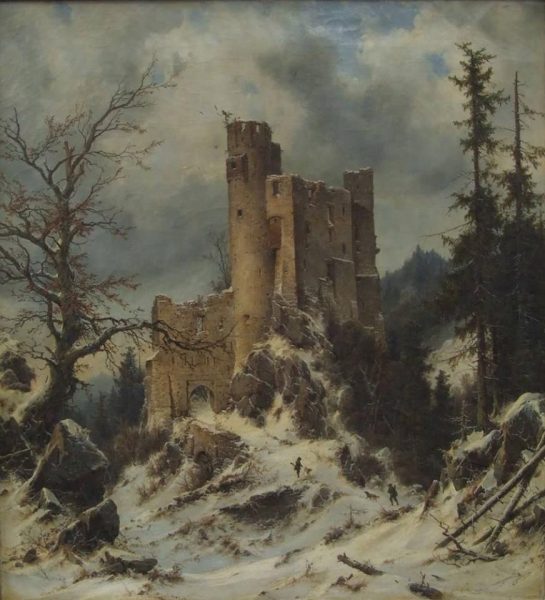 The Wilderness Exploration Game
The Wilderness Exploration GameWhile the rules for character advancement, combat, and dungeon exploration in the Basic rules are already pretty nice as a rules light version of D&D, it’s really the Exploration rules that always keep me coming back to this game. I remember when West Marches by Ben Robbins was first making its rounds and it always seemed like a really cool approach to set up a sandbox campaign. I later was greatly inspired by Joseph Manola’s The long haul: time and distance in D&D about approaching adventures as months-long expeditions into the unknown, interrupted by spending months cooped up in winter camp. More recently, I’ve read Gus L’s series on Classic Dungeon Crawls that emphasizes the survival game aspect as being essential to making the exploration of dungeons an engaging mode of play, and the whole time I was thinking “Yes, but what if we apply all of this to the outdoors?!”
I feel the wilderness has always been overshadowed by dungeons and by city adventures, but my own mental images of amazing fantasy worlds are filled with trees and mountains from horizon to horizon. And pondering on the ideas of the three wise men above, I’ve become convinced that there can be absolutely fantastic campaigns in which the wandering around in the wilderness can be the main attraction, rather than just the connecting transition space between different adventure sites. To make such a campaign work, there needs to be a clear campaign structure, as well as a set of easy to use tools for the GM to make it happen.
As campaign structure goes, the concept very much follows the West Marches and the original Basic rules: The game begins with 1st level PCs in a small frontier town that is relatively close to several ruins and caves that are home to various creatures and hiding ancient treasures. At first adventures are relatively short, with the travel to the sites being quick and probably uneventful and dungeons being fairly small, and all the PCs being back in the town after 3 to 5 hours where they get XP for all the treasures they recovered. Dungeons with more dangerous creatures and greater treasures tend to be farther away from the town and descend into greater depth, leading to increasingly longer adventures that eventually won’t be able to be played in a single go.
At this point it becomes strongly encouraged for the players to have more than a single character to deal with scheduling. If players A, B, C, and D go on a longer adventure with characters A(1), B(1), C(1), and D(1), the adventure can’t continue until all four players can come together at the same time with the GM again. If player C can only play every second week (maybe), but players A, B, and D want to play more often, they can go on another adventures with their character A(2), B(2), and D(2), and maybe also take along two other players with their characters E(1) and F(1)? If the campaign is about uncovering the secrets and mysteries of the wilderness instead of the personal stories of individual PCs, this way of playing multiple PCs is perfectly viable and it increased scheduling flexibility immensely. It also makes long healing times and characters working for weeks or months on creating magic items and similar things more viable. Just because one character is out of action for the game doesn’t mean all the other PCs have to sit around and fiddle their thumbs while they are waiting.
The Expert rules recommend that characters should start going on longer journeys deep into the wilderness and away from civilization around 4th level, which I think remains a good guideline. But I also think that this is actually the perfect time for PCs to start establishing their own stronghold. Not as barons ruling over their respective towns and villages (which isn’t really much of a group activity anyway), but to have a new forward base camp for their exploration deeper into the wilderness. It’s a place where they can stash their newly found treasures in their vault (and get XP for said treasures), have a supply depot with food reserves for months, can set up fully stocked shops for armorers and alchemists, and a garrison for the hired mercenaries who guard the vault and stay with the pack animals and supplies while they go down into dungeons to explore. It can also serve as their winter camp when the whether makes campaigning nearly impossible for several months of the year.
This new stronghold not only serves as an alternative for the starting town for launching new adventures deeper into the wilderness, it also functions as a generator for new adventures. Ben Robins recommends that the PCs should be the only adventurers exploring the West Marches, but the players don’t have to be the only people establishing a new outpost on the very edges of civilization. There can also be the keeps of aspiring new barons, mining camps, bandit camps, and of course endless hidden lairs of evil cults. Not to mention monsters like giants and dragons making their homes in the area. All of which could have a problem with the PCs setting up a new base near their own turf. Or potentially become allies to share resources and information, and aid each other in times of attacks.
The critical importance of random encounter in dungeon explorations is well enough known, but the same mechanic can also do an incredible amount of heavy lifting when it comes to the wilderness. Nearly everything that can be encountered in the wilds or on the road is either going somewhere or coming from somewhere. After the encounter has played out, there’s usually an option for the players to either follow the creatures to where they are going, or to follow their trail to where they came from. This is a fantastic opportunity to introduce new sites to the sandbox. People probably have noticed that the numbers of creatures encountered in the wilderness often goes into the dozens, and in the case of some lairs even in the hundreds. These numbers are not for a group of four PCs being suddenly ambushed by an entire army on the march. These are numbers for populating keeps, camps, and lairs. These groups are what you find when you follow the wandering groups of monsters back to their homes. And they don’t have to be hostile. The same reaction rolls for random encounters in dungeons can be used when approaching a stronghold in the wilderness. Which I think has the potential as an amazing tool to create a wilderness area that is a living space where players can discover the unexpected and the GM has fantastic opportunities for very freeform and improvisational play.
As I mentioned, a campaign like this also needs tools. The following are mechanics that I’ve already dabbled with to make running such adventures easier. Some of which overlap with the changes to the basic game mechanics mentioned in the previous section. Most of these are things that the Expert rules already cover, but I feel they are clunky and inconvenient to use. All of it can be done better without dramatically changing the outcomes.
The final piece for my upcoming campaign during which all these ideas for new rules and mechanics will be playtested is the setting. I like the sound of Aumaril, and I checked that it isn’t already used by something else. And it’s different enough from Arduin and Amalur to not seem like a knockoff.
Aumaril is a world dominated by severe weather and many volcanoes. Volcanic activity covers the sky in ash every few decades that can cause brutal winters and ruin harvests, but on some occasions have tipped the climate to a point of causing ice ages that can range from centuries to tens of thousands of years. The world only emerged from four thousand years of winter fairly recently, which destroyed the civilization of the fey, reduced the kingdoms of the giants to barbarism, and diminished the empires of the serpentmen to a shadow of their former greatness. As the ice retreated and forest returned to the northern lands, mortal barbarians migrated from the south to make them their home. In recent generations, these first mortal empires have fallen into chaos and decay, and many people are fleeing deeper into the wilderness to try their luck among the abandoned ruins of the fey and giants, and things much more older than even the ancients.
While civilization is centered around three old empires that have seen much better days, and could be interesting places for adventures in their own right, these are not the actual setting where the planned campaign takes place. The adventures of the PCs cover the vast wilderness of forests and mountains that still cover most of the world and remain largely unexplored, but have many ancient ruins from the previous age and civilizations that have long since disappeared. I am an unashamed fan of the 70s and 80s Sword & Sorcery style that gratuitously blends together traditional medieval fantasy elements with weird and alien environments from science fiction or prehistoric Earth. Mushroom forests, dinosaurs, and giant insects are totally my jam, as are evil sorcerers in giant black towers covered in skulls. Which I think has never been executed better (at least stylistically) than in Morrowind. I’m not leaning as much towards the camp or melodramatic, but I still think this is a really cool aesthetic that can be just as well suited for more down to earth fantasy adventures.
One thing that really excites me about this setting is that it’s being populated by various intelligent creatures that have been created for D&D pretty long times ago, but never really seen much breakout success or prominent appearances. In addition to the very human-like Aumarilians, who are greatly inspired by various cultures from the Hyborean Age and the Elder Scrolls, the other major peoples are chitines, derro, fey’ri, grimlocks, locathah, quaggoths, raptorans, and stone giants. Goliaths seem to have become quite popular in 5th edition, and of course yuan-ti have always been famous.
This part of my great creation probably won’t see any kind of proper release as some kind of book, but I guess I’m probably going to share various bits and pieces about it here as the actual campaign develops.
I’ve been thinking more about my ideas for a Pleistocene inspired setting and how I can combine it with the general outline I’ve already drawn out for my new mystical wilderness world. And I really like where things are going.
 The world consists of three primary realms. The natural world of Earth, Water, and Air sits at the center as the home of humanoids, animals, and various nature spirits. It’s the realm of the elements from which druids draw their magical powers.
The world consists of three primary realms. The natural world of Earth, Water, and Air sits at the center as the home of humanoids, animals, and various nature spirits. It’s the realm of the elements from which druids draw their magical powers.
Above the natural world exists the celestial realm. It’s the world of stars and moons, home to strange and elusive beings that are pure spirits with no physical substance, and the source of the magical powers wielded by mystics (clerics).
Beneath the natural world is the underworld. It’s the realm of demons and infernal fire. The infernal fire is found in the essence of demons and volcanoes. Sorcerers and warlocks gain some of their magical power from the infernal fire, but also draw on the energies of the celestial sphere.
In addition to the three main realms, there are also the forces of elemental fire and elemental cold. They are the driving forces of the seasons but also the cycle of the ages. The elemental fire is manifested in the sun, while elemental cold seems to come from both everywhere and nowhere. Nobody really knows for sure if fire and cold are equal but opposite forces, or if cold is simply the natural state of the world that will reassert itself whenever the warming influence of the sun is waning. But some people believe that there is a counterpart of the sun beneath the eternal ice of the north pole.
Ancient myths shared by most temples and cults tell that for most of the existence of the world, all the lands were covered in ice and snow, cast in eternal darkness without the warming light of the sun. But like the changing of the seasons, there is a cycle of the ages, and after hundreds of thousands of years, the sun will reappear and the world awaken from its long sleep. Glaciers melt and forests grow back, and new animal life returns to the world. But eventually, these ages of the sun will end, and the world return to its natural state of lifeless cold and darkness.
The oldest tales of known history begin with the end of the last Great Frost. This world became inhabited by the fey, giants, and serpentmen who made its wild forests and plains their home for many thousands of years. However, their world ended with the beginning of the Long Winter some 10,000 years ago. The Long Winter was not a true Great Frost that would end all life on the surface of the world, but the sun became dim and the great glaciers in the far north began to grow and expand south, covering much of the known world under their ice. During the Long Winter, the fey went to slumber in burrows under the earth. The giants survived in small nomadic clans roaming the cold tundra at the feet of the glaciers. And the serpmentmen fled far to the south where the warmth of the sun allowed for forests to survive. During this time, even the gods went to sleep, with only the celestial goddesses of moonlight and darkness watching over the frozen world.
The Long Winter lasted for 6,000 years until spring finally returned to the known world and the great glaciers began to melt. Plants and animals returned to the warming lands, but this time they were also accompanied by people. As they explored these new lands, they came upon old ruins of the elder races and discovered in them the secrets of magic. These first sorcerers became the first mortal kings, establishing both the Western and the Eastern Kingdoms, which became the centers of the newly rising civilizations. Not all barbarians were happy with the rule of kings, and many clans continued traveling further north into the expanding forests to evade their reach. With the Western Kingdoms and the Eastern Kingdoms regularly fighting among themselves, with each other, or against the ancient Serpentmen Kingdoms that have survived in the South, there are always people looking to the wilderness in the North to seek a new life among the barbarian clans. A vast land promising freedom and adventure.
After spending a month with a really deep dive into The Savage Frontier and having recently started playing Skyrim again, I am currently having a lot of subarctic environments wandering in my mind. My first thoughts for a new setting had been to fall back on trying something in an Indo-Iranian Bronze Age style with perhaps some Mediterranean elements again, since I really don’t think anyone needs yet another Viking setting. But I had also set out to start something new and fresh instead of just stirring around the same pot of ideas that had gotten somewhat stale after ten years. And I did tinker around a bit with Baltic and Slavic setting elements in the past, though ultimately nothing really came from that. Instead of doing more Bronze Age stuff, which I still think is greatly underserved in fantasy, I think doing something more influenced by late Iron Age and Migration Period Northern and Eastern Europe could also be really cool. Also a pool of ideas for fantasy that barely anyone ever seems to go fishing in.
I already had the idea for the new setting that there was a fairly recent Ice Age that erased all the ruins of the Ancients from the surface, leaving the few remnants of their empires hidden away in underground caves. And I really love the common thing in lots of old Sword & Sorcery art to have human barbarians alongside long extinct animals from much more ancient aeons. The idea of having a late Pleistocene environment combined with broadly 4th century Baltic and Slavic people actually does sound pretty fun to me.
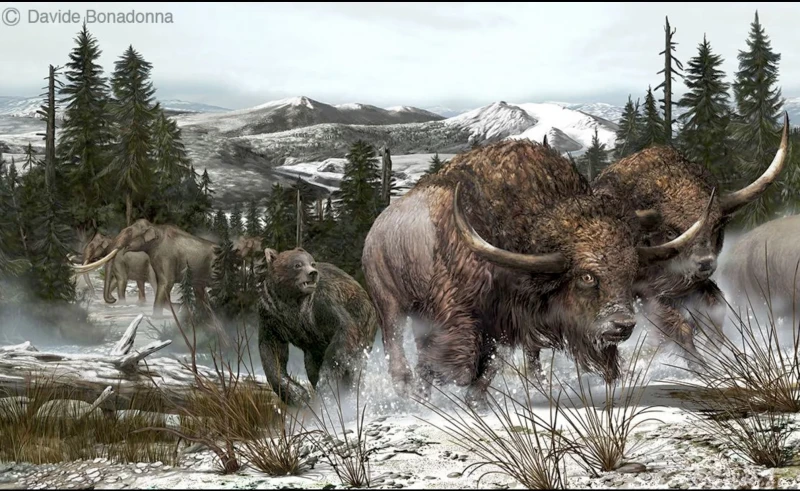 I’ve been thinking for a long time that the typical European lineup of animals in Fantasyland is pretty boring. Wolves, bears, horses, cows, and wild pigs are just so everyday pedestrian for someone from central Europe. There is nothing really fantastical about it. But you don’t really have to go that far back and you have mammoths, ancient bisons, and sabre-toothed cats in the same places. Which are still perfectly realistic animals because they were real, but also much more foreign and exotic.
I’ve been thinking for a long time that the typical European lineup of animals in Fantasyland is pretty boring. Wolves, bears, horses, cows, and wild pigs are just so everyday pedestrian for someone from central Europe. There is nothing really fantastical about it. But you don’t really have to go that far back and you have mammoths, ancient bisons, and sabre-toothed cats in the same places. Which are still perfectly realistic animals because they were real, but also much more foreign and exotic.
Growing up in Northern Germany, pretty much smack in the area where the massive glaciers of the last three ice ages reached their greatest extend, Ice Age stuff popped up quite a lot in my childhood. Often in school, but of course natural history and archeological museums around here usually had Ice Age exhibitions as well. I thought that stuff was pretty cool, but when you’re seven years old it’s not nearly as interesting as dinosaurs. Way more awesome than fluffy elephants. Back then at such a young age, I had no frame of reference for the time scales involved. But looking into these things now, I find it really fascinating that all the lands around here and to the north were nothing but bare rocks and sand under hundreds or even thousands of meters of ice only 12,000 years ago. And had been in that state for some 100,000 years. Everything that exists north of the German central hills and the mountains of Czechia is less than 12,000 years old. Even all the wilderness of Scandinavia that seems as ancient and untouched as anything can possibly be in Europe goes only back that far. All the plants and animals that exist there migrated to these lands only very recently from warmer lands to the south. And the Ice Age wasn’t a short temporary exception that disrupted the natural environment. The last three Ice Ages each lasted for about a 100,000 years each, with the periods between them only some 20,000 years in length. The fact that Northern Europe has an ecosystem right now is actually weird and not typical for this part of the world. I find this hugely fascinating and a great source of inspiration.
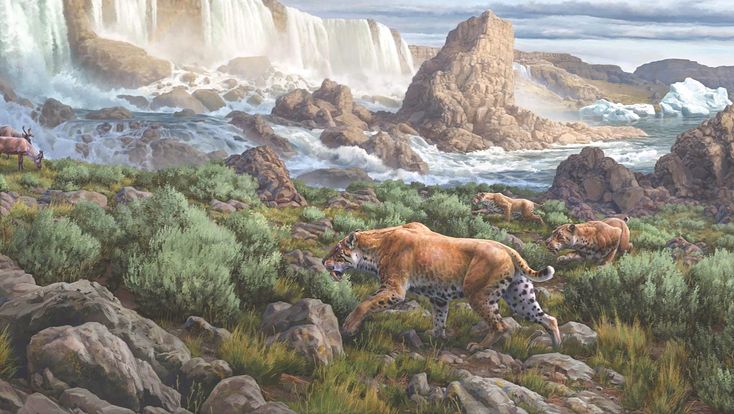 I am now considering stepping somewhat away from having the main civilization of the new setting consisting of warring city states ruled by immortal sorcerer-kings like Dark Sun or Morrowind, and instead putting the focus squarely on the wilderness beyond the border of civilization. The lands in the largely untamed wilderness where the clans that rejected the new structures of civilized kingdoms retreated to, and where people fleeing the reach of the current kings attempt to find refuge.
I am now considering stepping somewhat away from having the main civilization of the new setting consisting of warring city states ruled by immortal sorcerer-kings like Dark Sun or Morrowind, and instead putting the focus squarely on the wilderness beyond the border of civilization. The lands in the largely untamed wilderness where the clans that rejected the new structures of civilized kingdoms retreated to, and where people fleeing the reach of the current kings attempt to find refuge.
Studying The Savage Frontier in much greater detail than I ever did before has given me a lot of insights about how that region of the Forgotten Realms is structured and how its map can be a great inspiration for adventures that are not spelled out in the texts. But it also made me notice various aspects of where the design falls short and things could have been set up in much more interesting ways. So at this moment, I am very much considering to take the ideas I already came up with for a new setting and turn them into something that could be regarded as my own take on the overall concept of the Savage Frontier and Skyrim. But more alien and more weird like Hyperborea. And without Vikings.
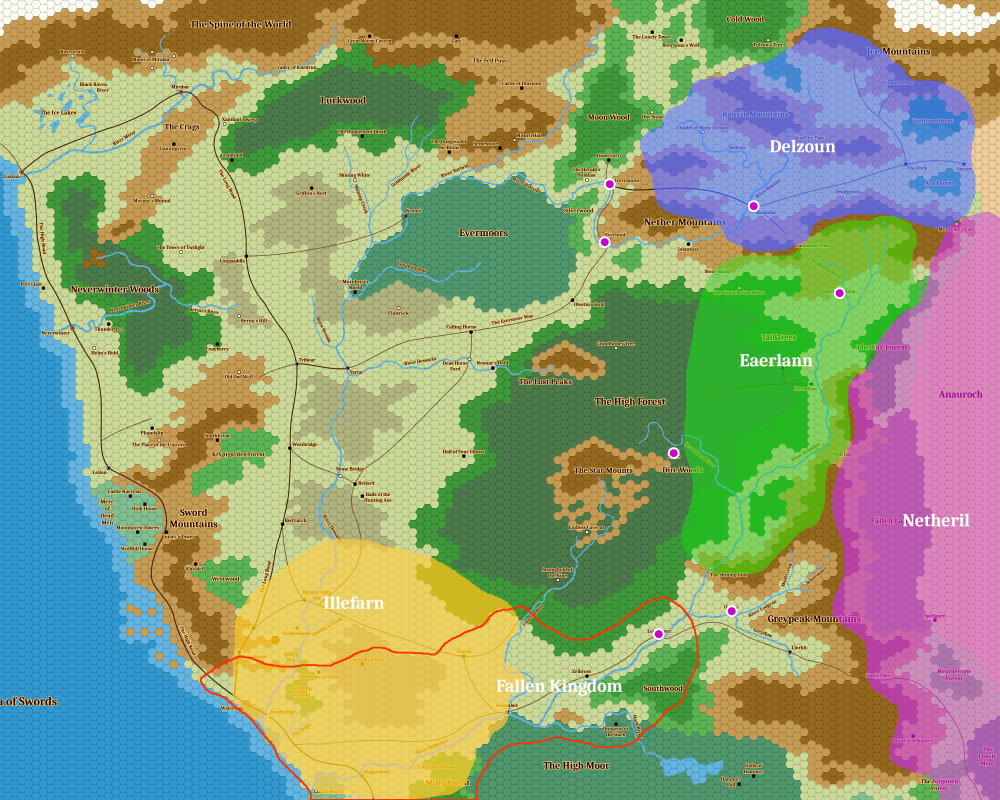 The ancient borders of Eaerlann, Netheril, and Delzoun are fairly well described in the material. In contrast, the borders of Illefarn and the Fallen Kingdom are only mentioned very vaguely and the outlines here are purely my own personal guess.
The ancient borders of Eaerlann, Netheril, and Delzoun are fairly well described in the material. In contrast, the borders of Illefarn and the Fallen Kingdom are only mentioned very vaguely and the outlines here are purely my own personal guess.
One discrepancy in the description of the elven realms is with the inhabitants of Eaerlann. “For millennia, gold elves dwelt in Illefarn (where
Waterdeep now stands) and Eaerlann (along the River Shining).” This sentence seems to state that the people of both Illefarn and Eaerlann were gold elves. However, it is stated in other places that the half-elven renegades of the High Forest are descended from moon elves. It is also stated that the only known group of elves still living in the North are moon elves in Ardeep Forest. And Ardeep Forest is one of the explicitly mentioned places belonging to the Fallen Kingdom, which was founded by elves from Earlann long after the elves of Illefarn had all left for Evermeet. I believe this to be a case of editorial error and that Eaerlann was in fact a realm of moon elves. Wood elves are never mentioned at all in any of the 1st edition sources for the region.
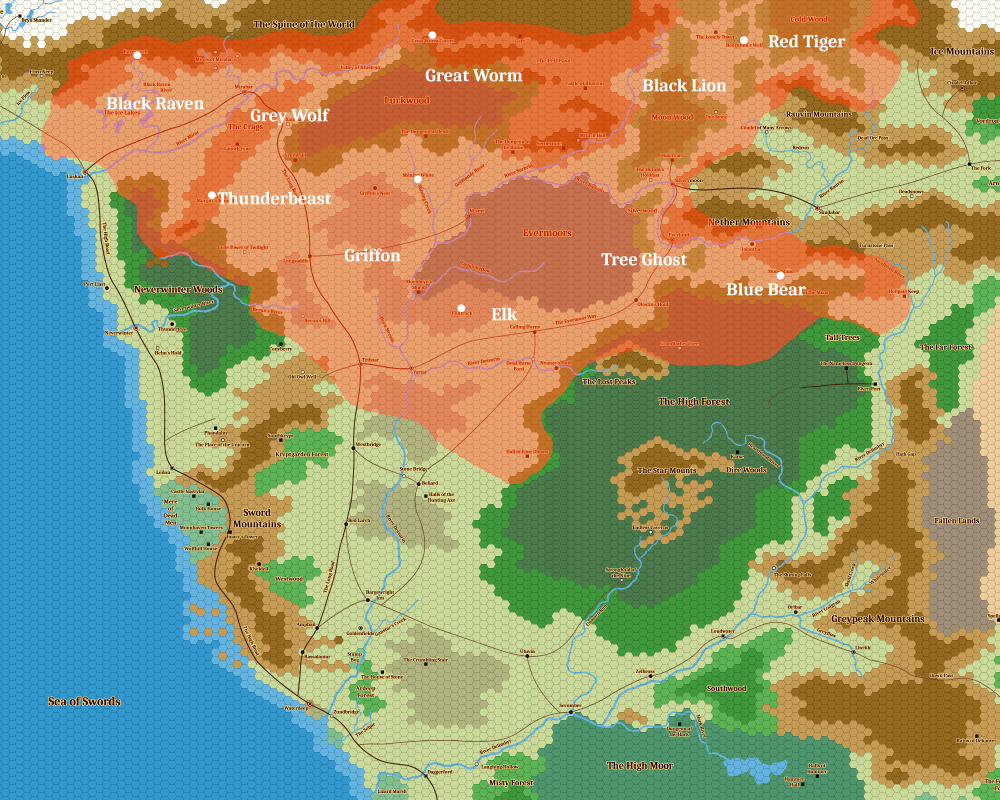 I have never actually seen any maps showing the areas that the Uthgard tribes are calling their homes. All we’ve ever been given explicitly are the locations of their holy ancestor mounds and the towns of Griffon’s Nest and Grunwald. However, the descriptions given on each tribe in The Savage Frontier does provide quite a bit information to work with, which resulted in this interpretation of where the Uthgardt would commonly be encountered. Not much information is given on the way the Uthgardt live, but it appears that they do not practice any kind of farming, and so probably rely on a combination of hunting, gathering, and possible some herding.
I have never actually seen any maps showing the areas that the Uthgard tribes are calling their homes. All we’ve ever been given explicitly are the locations of their holy ancestor mounds and the towns of Griffon’s Nest and Grunwald. However, the descriptions given on each tribe in The Savage Frontier does provide quite a bit information to work with, which resulted in this interpretation of where the Uthgardt would commonly be encountered. Not much information is given on the way the Uthgardt live, but it appears that they do not practice any kind of farming, and so probably rely on a combination of hunting, gathering, and possible some herding.
When comparing this map with my earlier map of the areas where towns are located and most farming would be done, the areas where the two overlap happen to be the ones of the Grey Wolf, Griffon, Elk, and Blue Bear tribes. Which also are just the tribes that most commonly come in conflict and attack the new settlers. Which makes me think that there really was some thought put into the placement of towns and tribes, and gives me more confidence that my interpretations are pretty good.